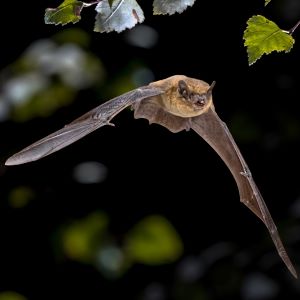
Planning for bats
As a protected group of species, considering whether bats are affected is important in planning for wildlife.
Planning for bats requires specialist skills and licences for survey and mitigation.
Knowledge of their ecology and legal protections can help with successful design that benefits you and them.
Our specialist bat reports and assessment can help you demonstrate the sustainability of your development and deliver your project.
When might a bat survey be needed ?
Bat surveys will often be requested when a building is being converted or demolished; or where tree works or felling are required for construction. The surveys will gather data on whether bats are present and if so which species and what type of roost there is. For instance, female bats often gather in large summer maternity roosts that are very important for conservation.
The data allows an assessment on how bats might be affected and whether these impacts can be avoided. It also assists in a sustainable design to allow for bats.
Where are bats found ?
Bats are a diverse species group: species such as common pipistrelle bats are common throughout England and Wales, even in quite urbanised environments. Rarer species, such as barbastelles, are dependent on more specialised habitats. Bats are commoner in more wooded landscapes or where there are mosaics of trees, water and unimproved grassland, e.g. within river valleys.
Different species have differing roost requirements. In summer species such as pipistrelles roost in crevices and under roof tiles and others such as brown long-eared bats use loft spaces. Woodland species such as noctules depend on tree cavities for roosting.
Typically bat roosts are more commonly found in older buildings in isolated localities such as barns, listed buildings and churches. More modern buildings are also used though and cavity walls and attics form ideal warm spots for maternity colonies.
What does a bat survey involve ?
Bat surveys of potential roosts generally start with a preliminary roost assessment, based on a desktop appraisal and a day-time visit to look for signs of bats, such as droppings. The suitability of the site can then be assessed or presence of bats reported and recommendations on the need for further surveys ( if any ) made.
The further surveys will generally be nocturnal, using specialised bat detectors to record nighttime activity at the site, especially bats emerging and returning to roost. Whilst active at night, bats can generally be identified to species by analysing their ultrasonic calls and their flight patterns.
Species of bat can also be identified from droppings collected from roosts using analysis of their DNA.
There may also be an assessment of present light levels to identify important conditions and mapping of habitat features.
What time of year can bat surveys be carried out ?
Initial site appraisals can be carried out at any time or year. Nocturnal follow-up surveys generally take place between May and September. For specialised locations such as underground sites where hibernation is suspected, surveys will take place in winter.
What happens if bats are found ?
If bats are found early, sometimes existing roosts and habitat features can be retained in the site design without affecting bats. Carrying out works during the winter may avoid temporary impacts from constuction as well. Assessing whether there are effects and how they can be avoided requires careful consideration and specialist advice.
If effects on bats can’t be avoided then a package of mitigation will be needed to minimise long-term impacts and to prevent bats from being injured if they might be present during the period of works. Compensation in the form of new roosts or habitat such as boxes and new hedgerows may also be required.
Once a package of mitigation has been agreed then it needs assessing as to whether it can be delivered with or without a licence from Natural England.
Bat licencing with Natural England
Natural England issues bat licences to developers allowing temporary impacts on bats provided that there is no long-term effects on their populations. The application requires a named ecologist, who is suitably qualified to supervise the work, and they will also assist you in preparing the application and supervising carrying it out. Planning permission ( or Listed Building Consent ) needs to have been granted before the application is made.
Licences take from upwards of 6 weeks to be issued by Natural England, but can be of several years duration. A licence fee has been recently introduced for certain types of development.
Where the licence is required for public safety, e.g. where a building might imminently collapse and injure someone, licences are issued by a quicker route.
When works are complete, monitoring of bats may take place to see if the works appear to have been successful. This also allows a way to identify any problems and fix them.
